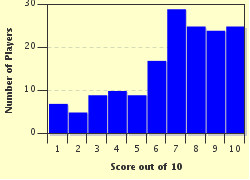Quiz Answer Key and Fun Facts
1. The suffix -gon means side and is a part of the words pentagon, octagon, dodecagon. How many sides does each of these figures have?
2. The Greek suffix -hedron, which means face of a three-dimensional figure. The heads of certain viruses are icosohedral. What is an icosahedron?
3. What is the language of origin of the term quadrilateral?
4. What common math term means "for every one hundred" in Latin?
5. The prefix nano- is used for one billionth. What does nano mean in Greek (it has the same meaning in the Italian language)?
6. Computers have had storage devices in the gigabyte range for years, but now drives are available that are over one thousand gigabytes. What is the unit describing one trillion bytes?
7. Hexahedron is another word for this figure with the Greek name kubos. What is the more common name for this polyhedron?
8. What the heck does pastry have to do with math? No silly, pi not pie. What is pi?
9. This letter is often used for angle measure. What is this letter, which is the eighth letter of the Greek alphabet and is associated with death?
10. What name, describing a property of a circle, comes from the Latin word meaning ray?
Source: Author
drbabe
This quiz was reviewed by FunTrivia editor
crisw before going online.
Any errors found in FunTrivia content are routinely corrected through our feedback system.

